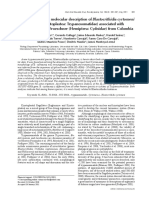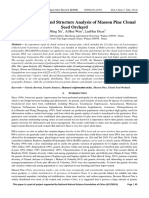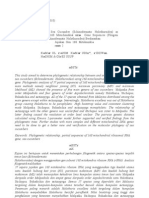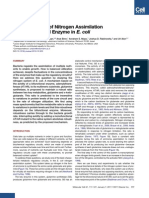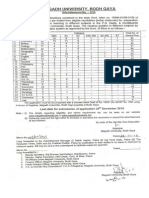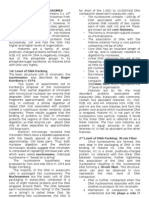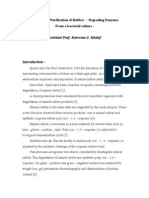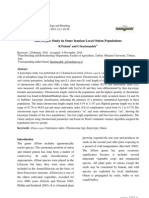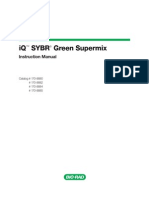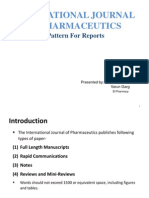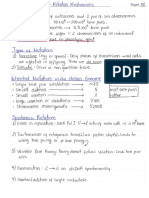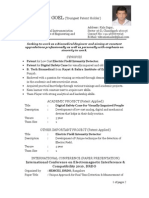Phylogeny of The Genus Inferred From Its And: Morus (Urticales: Moraceae) TRNL-F Sequences
Phylogeny of The Genus Inferred From Its And: Morus (Urticales: Moraceae) TRNL-F Sequences
Uploaded by
prabodhdrdoCopyright:
Available Formats
Phylogeny of The Genus Inferred From Its And: Morus (Urticales: Moraceae) TRNL-F Sequences
Phylogeny of The Genus Inferred From Its And: Morus (Urticales: Moraceae) TRNL-F Sequences
Uploaded by
prabodhdrdoOriginal Title
Copyright
Available Formats
Share this document
Did you find this document useful?
Is this content inappropriate?
Copyright:
Available Formats
Phylogeny of The Genus Inferred From Its And: Morus (Urticales: Moraceae) TRNL-F Sequences
Phylogeny of The Genus Inferred From Its And: Morus (Urticales: Moraceae) TRNL-F Sequences
Uploaded by
prabodhdrdoCopyright:
Available Formats
African Journal of Biotechnology Vol. 4 (6), pp. 563-569, June 2005 Available online at http://www.academicjournals.
org/AJB ISSN 16845315 2005 Academic Journals
Full Length Research Paper
Phylogeny of the genus Morus (Urticales: Moraceae) inferred from ITS and trnL-F sequences
Zhao Weiguo1,2, Pan Yile1*, Zhang Zhifang Jia Shihai2, Miao Xuexia2, Huang Yongping2
1
Sericultural Research Institute, Chinese Academy of Agricultural Sciences, Zhenjiang City, Jiangsu Province 212018, China. 2 Shanghai Institute of Plant Physiology and Ecology, Shanghai Institute for Biological Sciences, Chinese Academy of Sciences, 300 Fenglin Road, Shanghai 200032, China.
Accepted 20 April, 2005
Both nuclear ribosomal ITS and chloroplast trnL-F sequences were acquired from 13 mulberry genotypes belonging to nine species and three varieties, and one paper mulberry. The later belongs to genus B. papyrifera, designed as outgroup, and were analyzed. Within the genus Morus, the sequence diversity of ITS was much higher than that of trnL-F. The results of phylogenetic analyses based on these data (separately or combined) show that the genus Morus is monophyletic group. Strict consensus tree obtained through the Neighbor-joining method can be divided into five major clades in the genus Morus, according to combined sequence data. M. bombycis, M. alba var. venose formed clades A and B, respectively. Clade C comprises of 5 species; M. rotundiloba, M. atropurpurea, M. mongolica, M. australi, and M. mongolica var. diabolica. Clade D comprises of 3 species; M. wittiorum, M. laevigata, and M. alba. Clade E comprises of 2 species; M. multicaulis, and M.alba var. macrophylla. The results from cluster analysis were basically in agreement with the existing morphologic classification. Key words: Morus, phylogeny, ITS, trnL-F.
INTRODUCTION Mulberry (genus: Morus), grown as a perennial tree or shrub is an economically important plant used for sericulture, as it is the sole food plant for the domesticated silkworm, Bombyx mori. Morus, which is widely distributed in Asia, Europe, North and South America, and Africa, is cultivated extensively in East, Central and South Asia for silk production. A few species of mulberry are also valued for their edible fruit (M. alba and M. laevigata),and timber (M. laevigata and M. serrata). Whereas it has been widely believed that mulberry species originated on the low slopes of the Himalayas bordering China and India, the study of Hou suggests a multicentered origin (Hou, 1994). Mulberry belongs to the order Urticales and the family Moraceae. Since the classification of the genus Morus was firstly established by Linnaeus in 1753 mainly based on morphological characteristics, considerable differences exist among systematists as to the number of species that exist in this genus (Koidzumi, 1917, 1923; Hotta, 1958; Katsumata, 1972; Airy Shaw, 1973). Major contribution to the systematic of Morus was made by Koidzumi (1917, 1923). He classified the species under two sections, the Dolichostylae (long style) and the Macromorus (short style), under which recognized the group Papillosae and Pubescentae based on the nature of stigmatic hairs. For further classification, he used morphological characters of leaf, inflorescence and sorosis. So far, more than 150 species of mulberry have
*Corresponding Author. E-mail: wgzsri@sina.com.
564
Afr. J. Biotechnol.
been cited in the Index Kewensis, but a majority of them have been treated either as synonyms or as varieties rather than species, and some have been transferred to allied genera. Because of environmental influence, phenotypic traits in many cases fail to serve as unambiguous markers for systematics and diversity analysis (Wang, 1989). Moreover, most of the putative mulberry species are dioecious and can cross-pollinate among themselves to produce fertile hybrids, suggesting that they have relatively close genetic relationships. Such a high degree of cross-species reproductive success is not encountered often in nature, and has thus created considerable doubt with regard to the species status of mulberry. In addition, taxonomic studies have been confined only to the sericulturally important species; and for other species, enough information is not available. At present the classification of the Morus is rather highly debated and arbitrary one (Dandin, 1998). Recent advance in molecular biology provides a convenient and rapid assessment of the differences in the genetic composition of the related individuals using DNA sequence data. In China, there are about 3,000 mulberry germplasm resources, which comprise 15 species and 4 varieties, its types and quantities ranks No.1 in the world (Pan, 2000). Taking advantage of numerous mulberry resources in China, we here assess the relationships of Morus and related genus with sequences from the chloroplast trn L(UAA)-trnF(GAA) region (trnL-F), and the internal transcribed spacer (ITS) region of nuclear ribosomal DNA. Both of these regions have proven phylogenetically informative for inferring relationships in various plant groups (Carine Brouat et al., 2001; Akiko et al., 2004 ; Gang Hao et al., 2004), particularly at the intergeneric or interspecific levels (e.g., Chassot et al., 2001; Mast et al., 2001). The main objectives of this study are: (1) to evaluate molecular phylogenies of Morus, and (2) to assess whether they corroborate existing classifications of the genus.
MATERIALS AND METHODS Materials Fourteen individuals representing 9 species and 3 varieties of Morus and one individual of paper mulberry belonging to genus B. papyrifera, designated as outgroup, were included in this study. All mulberry genotypes are deposited in the National Mulberry Gene Bank of the Sericultural Research Institute, Chinese Academy of Agricultural Sciences (CAAS), Zhenjiang, Jiangsu province, China (Table 1). DNA extraction Total genomic DNA was extracted from fresh young leaves following the method described by Doyle and Doyle (1987) and modified as follows: 1.5 g young leaves were ground in liquid nitrogen to a fine powder and extracted with hot cetyltrimethylammonium bromide (CTAB) extraction buffer [50 mM Tris-HCl, pH 8.0, 1.4 M NaCl, 20 mM EDTA, 2% (w/v) CTAB, 2% PVP(w/v) and 1% (v/v) -
mercaptoethanol]. The mixture was incubated at 60 C for 30 min, followed by two extractions with chloroform/isoamyl alcohol (24:1). Isopropanol was used to precipitate nucleic acids and the pellet was dissolved in Tris-EDTA (TE) buffer (10 mM Tris-HCl, pH 8.0 and 1 mM EDTA, pH 8.0). RNA was removed by digestion with deoxyribonuclease-free ribonuclease and remaining impurities were extracted with chloroform. Total DNA was precipitated using cold ethanol, the precipitate was washed twice with 75% ethanol, and the pellet was dissolved in TE buffer. The purified total DNA was quantified by gel electrophoresis and its quality verified by spectrophotometry. DNA samples were stored at 4 C. PCR amplification PCR amplification was performed in a 50 l volume containing 2.5 mM MgCl2, 200 M of each dNTP, 5 pM of each primer, and 1.5 U of Taq DNA polymerase (Takara Bio Inc.), 10x PCR Buffer (100 mM Tris-HCl pH 8.3, 500 mM KCl, 0.01% gelatin), and approximately 25 ng DNA template. The trnL-trnF intergenic spacer was amplified with primers e and f(Taberlet et al., 1991). The primers "ITS5" and "ITS4" (White et al., 1990) were used to amplify the ITS fragment comprising ITS1, the 5.8S gene, and ITS2. Amplification reaction was carried out with following thermal cycles profiles: 1 cycle for 10 min at 95 C, then 35 cycles of 30 s at 95 C, 30 s at 55 C, 90 s at 72 C, followed by a final extension of 7min at 72 C. PCR product purification and sequencing The PCR product was run through a 1% agarose gel in 1x TBE buffer at 70-100 V. The PCR amplification band was excised from the agarose gel with a sterile razor blade. The excised band was incubated with 500-600 l of sodium iodide (NaI) solution (6 M) at 55 C in a waterbath to melt the gel. Approximately 10 l of GLASSMILK suspension was added and incubated at room temperature for 5 min. The solution was mixed with GLASSMILK by inversion every 1-2 min to ensure that it stays suspended. After 5 min, the GLASSMILK was spun down in a microcentrifuge for a few seconds. The NaI supernatant solution was removed and the GLASSMILK pellet was washed three times with 500-600 l of NEW WASH solution (10 mM Tris-HCl, 0.5 mM EDTA, 50 mM NaCl, 50% ethanol). After washing, the pellet was dried for 5 min. The pellet was resuspended with 20 l of sterile ddH2O and incubated at 55 C in a waterbath for 3 min. Then the pellet was spun down in a microcentrifuge for a few seconds and the supernatant containing eluted DNA fragment was transferred into a new microfuge tube. The purified PCR product was sequenced on an ABI 373 automated DNA sequencer using the Dye Terminator Cycle Sequencing Reaction Kit (PE Applied Bio-systems). Each fragment was sequenced for both strands. Data analysis Sequences of ITS and trnL-F were aligned with Clustal X, version 1.81, applying the default parameters (Thomson et al., 1997) and then manually adjusted for insertion/deletion mutations (indels) where necessary. The trnL-F sequences required only minor manual adjustment for alignment. ITS sequences required a higher level of manual adjustment for alignment. The regions of alignment ambiguity were excluded from phylogenetic analyses. The indels of unambiguous alignment were recoded as separate characters appended in the matrix. The data matrices are available upon request from the authors. The phylogenetic tree was constructed by the Neighbor-joining (NJ) method, version 3.6b of PHYLIP software. The phylogenetic tree was evaluated with bootstrap test on 1000 resamplings (Felsenstein, 1985).
Weiguo et al.
565
Table 1. The source of materials and GenBank Accession No.
Taxon Accessions Ploidy and chromosome number 2n=2x=28 Locality Morphological characters GenBank Accession No. (ITS; trnL-F) AY345153; AY271293
M. multicaulis Perr.
Naxisang
Naxi city, Sichuan province, China Yangcheng city, shanxi province, China
Style absent or indistinct, stigma papillose with protuberances inside. Leaf cordate generally unlobed, surface has wrinkled appearance, margin serrate, apex sharp obtuse, base cordate. Style absent or indistinct, stigma papillose. Leaf ovate or wide ovate, lobed and unlobed, surface smooth without wrinkles, apex acute or acuminate, margin usually blunt serrate or dentate, few serrulate or denticulate, base indented or shallowly cordate. Style absent or indistinct, stigma papillose. Leaf lager, surface smooth, apex acuminate, base shallowly cordate or trunate. Style absent or indistinct, stigma papillose. Leaf ovate with white vein, apex acuminate or argutidentate, margin serrate. Style absent or indistinct, stigma pubescentes. Leaf smaller generally unlobed, surface smooth or little wrinkled appearance, glossy, apex long acuminate or caudate, base shallowly cordate or trunate. Female flower with distinct long style, stigma papillose or pilose. Leaf mostly dentato-serrate, crenato-dentate rarely argutidentato-serrate margin. Bud scales glabrous Style very short, stigma papillose inside. Flower in spikes of 4-16 cm length. Leaf ovate or wide ovate, comparatively larger, no hairs on ventral part, margin serrulate, apex long cuspidate, base shallow cordate to truncate. Style long, stigma papillosae. Leaf ovate or ovatoelliptical, smooth without hair, apex long caudate or long acuminate, margin with triangle serrate, base cordate or trunate. Style long, stigma papillosae. Leaf ovate-rotundate or cordate ,usually lobed and hairy, apex caudate , margin with triangle serrate. Style long, stigma lancecolate, minutely papillose.Leaf margin dentato-serrate and denticels are nearly equal. Leaf is usually trilobate and apex of the lateral lobes is rotundate Style very short, stigma papillosae. Leaf long elliptical or elliptical generally unlobed, surface smooth , no hairs on ventral part, apex caudate, margin shallowly serrate or rotundate, base rotundate.
M. alba Linn.
Niuersang
2n=3x=42
AY345157; AY271279
M.. alba var macrophylla Loud. M. alba var venose Delile. M. atropurpurea Roxb. M. bombycis Koidz
Gongxianheiy ousang Wenqisang
2n=2x=28
Gongxian city, Sichuan province, China Zhouzhi city, shanxi province, China Sunde city, Guangdong province, China Japan
AY345148; AY271289 AY345149; AY271275 AY345145; AY271270
2n=2x=28
Lunjiao 40
2n=3x=42
Jianchi
2n=2x=28
AY345151; AY271290
M. laevigata Wall.
Dejiang 10
2n=3x=42
Dejiang city, gueizhou province,China
AY345147; AY271288
M. mongolica Schneid.
Jimengsang
2n=2x=28
Jilin province,China
AY345158; AY271285
M. mongolica var. diabolica Koidz M. rotundiloba Koidz.
Youmaoyansa ng T11
2n=2x=28
Guizhou province, China Thailand
AY345146; AY271287 AY345150; AY271286
2n=2x=28
M. wittiorum Hand-Mazz.
Qingesang 1
2n=2x=28
Dejiang city, gueizhou province,China Biejie city, gueizhou province,China Sichuan province,China
AY345154; AY271283 AY345155; AY271284 AY345152; AY271292
Gui 14
2n=4x=56
M. australis Poir.
Chasang
2n=2x=28
Style long, stigma pilose, shoot errect. Under surface of leaf light green and slightly hairy, leaf ovate, ovatooblong or ovato-elliptical, apex caudate, margin serrate with short prickles.
outgroups
B. papyrifera
Nanjing Forestry University,China
AY345156; AY271281
All mulberry materials sampled were from National Mulberry Genbank in the Sericultural Research Institute, CAAS, Zhenjiang, Jiangsu Province, China.
566
Afr. J. Biotechnol.
Table 2. Length (bp) and G+C contents of ITS1, 5.8s rDNA and ITS2 of genus Morus.
Materials Naxisang Niuersang Gongxianheiyousang Wenqisang Lunjiao 40 Jianchi Dejiang 10 Jimengsang Youmaoyansang T11 Qianesang 1 Gui 14 Chasang Average
ITS1 Length (bp) G+C % 189 59.3 181 189 190 189 188 189 197 189 189 189 189 189 189 59.1 59.3 60.0 59.3 58.5 59.8 58.9 59.3 59.3 59.8 59.8 59.3
5.8S rDNA Length (bp) G+C % 152 55.3 152 152 152 152 152 152 154 152 152 152 152 152 54.6 55.3 55.3 55.3 42.1 55.3 55.2 55.3 55.3 55.3 55.3 55.3
ITS2 Length (bp) G+C % 217 60.8 217 209 219 208 210 208 210 210 211 213 209 210 212 62.2 62.7 62.1 62.5 57.8 63.0 62.9 62.9 62.6 61.5 62.9 62.9
RESULT The ITS sequence The complete sequences of ITS1 and ITS2 (including 5.8 S, and a part of the 18 S and 26 S gene of rDNA) were determined for all mulberry materials. The sequence boundaries between the two ITS regions and three coding regions (18 S, 5.8 S, and 26 S) of rDNA in Morus were determined following Shi et al. (2001). The length of ITS1 varied between 181 and 197 bp and the length of ITS2 varied between 208 and 219 bp, while the length of the 5.8 S gene was consistent (152 bp) throughout all the mulberry taxa investigated, except for M. mongolica (154 bp) (Table 2). The 18 bp at the 3-end of the 18 S gene and the 15 bp at the 5-end of the 26 S gene was included in the phylogenetic analysis. Thus a total of 610 nucleotide positions (a part of 18S, ITS1, 5.8 S, ITS2, and a part of 26 S) was aligned as the ITS data set. Sixtysix variable positions (33.0%) within all materials are found in the ITS1 extended matrix, 47 of which are informative sites. Twenty-three variable positions (11.5%) within Morus are found in the ITS1 extended matrix, 19 of which are informative. Eighty-one variable positions (36.5%) within Morus are found in the ITS2 extended matrix, 46 of which are autapomorphic. ITS2 has higher sequence diversity than ITS1. The identity between these sequences varies in a range from 51.0 to100%, while the average identity between all mulberry accessions sequence is 96.2%, with a range from 90.0% to 100%. In addition, the identity between mulberry accessions and genus B. papyrifera sequence is below 60.0%. The result showed higher genetic similarity among mulberry accessions than with B. papyrifera.
Molecular phylogenetic analysis was done using ITS sequence data with B. papyrifera as an outgroup species. Strict consensus tree was obtained through the neighborjoining (NJ) method (Figure 1). The clustering result showed that all species of genus Morus grouped together, which indicated that Morus is monophyletic. The four major clades formed are indicated in Figure 1. The trnL-F sequence The trnL-F IGS region sequences were determined in this study and their length varied from 360 to 367 bp. The average nucleotide composition was 0.29935(A) 0.37448(T) 0.18379(C) 0.14238(G). The mean G+C content is 0.32617 %, which indicated that the spacer region sequences were characterized by AT-rich fragment. After alignment, there are 372 base positions in the trnL-F data matrix, of which 41 nucleotide sites were variable (11.02%) and 23 were parsimony-informative. Within Morus, there are 12 variable sites (3.2%), and 9 were potential informative sites. The average identity between these sequences is 98.1%, with a range from 89.9 to100 %, while the average sequence identity within Morus is 99.3%, with a range from 98.0 to100%. In addition, the average identity between mulberry accessions and B. papyrifera sequence is below 90.2%. The result further proved that among mulberry accessions there is higher genetic similarity, compared with B. papyrifera. Molecular phylogenetic analysis was done using trnL-F sequence data of each region with genus B. papyrifera as an outgroup species. Strict consensus tree was obtained through the neighbor-joining method (Figure 2). The clustering result also showed that all species of Morus
Weiguo et al.
567
Figure 1. Strict consensus phylogenetic trees obtained from the analysis of ITS data alone through the neighbor-joining method.
Figure 2. Strict consensus phylogenetic trees obtained from the analysis of trnL-F data alone through the neighbor-joining method.
568
Afr. J. Biotechnol.
Figure 3. Strict consensus phylogenetic trees obtained from the analysis based on the combined trnL-F and ITS data through the neighbor-joining method.
grouped together, which indicated that Morus is monophyletic. Six major clades were formed, as indicated in Figure 2. The relationships among those clades resolved by the trnL-F has some difference from those derived from the ITS data (Figure 1). However, the clade F in the trnL-F tree was basically consistent with the clade D in the ITS tree, all including M. wittiorum, M. atropurpurea, M. mongolica, M. mongolica var. diabolica, M. laevigata, M. australis. Combined analysis Because the phylogenetic signal recovered from both datasets is mostly concordant and there are no strongly conflicting placements within the ingroup, we assumed that the two sequenced molecules have evolved in parallel along the lineages that resulted in the present day taxa and that their respective data matrices could be combined into a single dataset and used for simultaneous analysis. The partition homogeneity test indicates that there is no significant incongruence between them. Therefore, the sequence data of ITS and trnL-F were combined for additional analysis. The combined trnL-F and ITS matrix was 982 bp long. Strict consensus tree was also obtained through the Neighbor-joining method
(Figure 3). The clustering result also proved that Morus is a monophyletic. Five major clades were formed, as indicated in Figure 3. DISCUSSION Mulberry is a perennial, heterogeneous outbreeding tree, the leaves of which are the exclusive food of the silk secreting insect, B. mori. Outbreeding in cultivated mulberry species is common and inter-species hybridization is often observed. Because of phenotypic plasticity, the occurrence of interspecific hybridization, mutation, and the absence of an unambiguous set of criteria for designating a true species, there is confusion in the systematic classification of mulberry. The present work evaluates the phylogenetic relationships of genus Morus using trn L-F and ITS sequences. Within Morus, the sequences of ITS is much longer than that of trnL-F. Twenty-three variable positions (11.5%) were found in the ITS1, Eighty-one variable positions (36.5%) were found in the ITS2, but there are only 12 variable sites (3.2%) in the trnL-F region. The three strict consensus trees from ITS, trnL-F and combined data showed that all species of Morus grouped together, which indicated that Morus is monophyletic.
Weiguo et al.
569
This result obtained from DNA sequences is consistent with previous research basing on study on isozymes and RAPD marker (Hirano 1982; Zhao et al, 2000). In addition, because there is no significant difference between the two data sets and the combined data analysis shows better resolution, the phylogenetic discussions below are based on this combined consensus tree. Strict consensus tree obtained through the neighborjoining method can be divided into five major clades, according to combined sequence data. M. bombycis and M. alba var. venose formed clades A and B, respectively. Clade C comprises of 5 species with the character of early budding; M. rotundiloba, M. atropurpurea, M. mongolica, M. australi, and M. mongolica var. diabolica. All species belong to Dolichostylae in the the morphological classification of Morus ( Koidzumi, 1917), except M. atropurpurea. Clade D comprises of 3 species; M. wittiorum, M. laevigata, and M. alba, all of which belong to Macromorus Papillosae in the the morphological classification. Clade E comprises of M. multicaulis and M. alba var. macrophylla, also belonging to Macromorus Papillosae in the morphological classification. The results from cluster analysis were basically in agreement with the existing morphologic classification. In summary, the phylogeny of Morus inferred from the ITS and trnL-F sequences is congruent with our current understanding of the group. These DNA regions offer a reliable and an efficient method of assessing phylogenetic relationship at the interspecific and intergeneric levels in mulberry. It is also helpful for the conservation and identification of mulberry collections, and in mulberry breeding. ACKNOWLEDGMENTS We express our thanks to Assoc. Prof. Zhang Lin, Mr. Liu Li and Mr. Cheng Yan for their assistance in conducting the experiments.
REFERENCES Airy Shaw HK (1993). A dictionary of flowering plants and ferns. 8th edition (JC Willis, revised by H. K.Airy Shaw) Cambridge University Press, London. Akiko S, Hidetoshi N (2004). Phylogenetic analysis of Asian Symplocos (Symplocaceae) based on nuclear and chloroplast DNA sequences. J. Plant Res. Chassot P, Nemomissa S, Yuan YM, Kpfer P (2001). High paraphyly of Swertia L. (Gentianaceae) in the Gentianella-lineage as revealed by nuclear and chloroplast DNA sequence variation. Plant Syst. Evol. 229: 1-21. Carine B, Ludovic G, Doyle McKey (2004). Phylogenetic relationships in the genus Leonardoxa (Leguminosae: Caesalpinioideae) inferred from chloroplast trnL intron and trnL-trnF intergenic spacer sequences. Am. J. Bot. 88:143-149 Doyle JJ, Doyle JL (1987). A rapid DNA isolation procedure for small quantities of fresh leaf tissue. Phytochem. Bull. 19:11-15
Dandin SB (1998). Mulberry a versatile biosource in the service of mankind. Acta Sericol. Sin. 24(2):109-113. Felsenstein J (1985). Confidence limits on phylogenies: an approach using the bootstrap. Evolution 39: 783-791. Gang H, Yong-Ming Y, Chi-Ming H, Xue-Jun G, Nan-Xian Z (2004). Molecular phylogeny of Lysimachia (Myrsinaceae) based on chloroplast trnL-F and nuclear ribosomal ITS sequences. Mol. Phylogenet. Evol. 31(1): 323-339. Hotta T (1958). Taxonomical studies on the Morus plants and their distributions in Japan and its viscinties. Japanese Society For Promotion of Science Ueno Park, Tokyo, Pp. 1-161. Hou YJ (1994). Mulberry breeding. Sericulture Department, Zhejiang Agriculture University, Hangzhou, China, p.4. Hirano H (1982). Thremmatological studies of protein variation in mulberry (in Japanese). Bull. I mp. Sericult. Exp. Sta. 28: 67-186. Koidzumi G (1917). Taxonomical discussion on Morus plants .(in Japanese) Bull. Imp. Sericult. Exp. Sta. 3:1-62. Linnaeus C (1753). Species Plantarum, Vol. 2. Stockholm. p. 986. Koidzumi G (1917). Taxonomical discussion on Morus plants. Bull. Imp. Sericult. Exp. Stat. 3:1-62. Koidzumi G (1923). Synopsis specierum generis Mori. Bull. Imp. Sericult. Exp. Stat. 11:1-50 Katsumata T (1972). Mulberry species in west Jawa and their peculiarities. J. Sericult. Sci. Jpn. 42: 213-23. Mast A, Kelso S, Richard AJ, Lang DJ, Feller DMS, Conti E ( 2001). Phylogenetic relationships in Primula L. and related genera (Primulaceae) based on noncoding chloroplast DNA. Int. J. Plant Sci. 162: 1381-1400. Pan YL. (2000). Progress and prospect of germplasm resources and breeding of mulberry. Acta Sericol. Sin. 26(Suppl): 1-8. Shi QL (2001). Preliminary study on ITS sequencing and characteristic of Mulberry. Acta Sericol. Sin. 27: 140-141. Taberlet P, Gielly L, Pauton G, Bouvet J (1991). Universal primers for amplification of three non-coding regions of chloroplast DNA. Plant Mol. Biol. 17: 1105-1109. Thompson JD, Gibson TJ, Plewniak F, Jeanmougin F, Higgins DG (1997). The Clustal-X windows interface: flexible strategies for multiple sequence alignment aided by quality analysis tools. Nucleic Acids Res. 25: 4876-4882. Zhao WG, Pan YL (2002). RAPD analysis for the germplasm resources of genus mulberry. Acta Sericol. Sin. 26(4):1-8. White TJ, Bruns T, Lee S, Taylor J (1990). Amplification and direct sequencing of fungal ribosomal RNA genes for phylogenetics. In: Innis, M, Gelfand D, Sninsky J, White T (Eds.) 1990. PCR Protocols: A Guide to Methods and Applications, Academic Press, San Diego, CA. pp. 315-322. Wang ZY, Tanksley SD (1989). Restriction fragment length polymorphism in Oryza sativa L. Genome 32: 1113-111.
You might also like
- 7000 Technical Ebooks Free Download (Links)Document572 pages7000 Technical Ebooks Free Download (Links)Javed Mohammed50% (2)
- BIochem AssDocument5 pagesBIochem AssCheng PasionNo ratings yet
- Rima VarietiescitruspaperDocument7 pagesRima VarietiescitruspaperElaine AguilarNo ratings yet
- Phylogeny and Evolution of Basils and Allies (Ocimeae, Labiatae) Based On Three Plastid DNA RegionsDocument23 pagesPhylogeny and Evolution of Basils and Allies (Ocimeae, Labiatae) Based On Three Plastid DNA RegionslinubinoiNo ratings yet
- Qin2017 - MorfologiaDocument19 pagesQin2017 - MorfologiaOlenka Alberca CruzNo ratings yet
- Cyrtomenus Bergi Froeschner (Hemiptera: Cydnidae) From ColombiaDocument7 pagesCyrtomenus Bergi Froeschner (Hemiptera: Cydnidae) From ColombiaAna CaicedoNo ratings yet
- Clave de Herpothallon 2Document10 pagesClave de Herpothallon 2Sergio Andres Galan AyalaNo ratings yet
- A Phylogeny of Euphorbieae Subtribe EuphorbiinaeDocument6 pagesA Phylogeny of Euphorbieae Subtribe EuphorbiinaeCrisMayaNo ratings yet
- Phylogenetic Relationships Between European and Chinese Tru Es Based On Parsimony and Distance Analysis of ITS SequencesDocument9 pagesPhylogenetic Relationships Between European and Chinese Tru Es Based On Parsimony and Distance Analysis of ITS SequencesAndrian KechagiaNo ratings yet
- Endangered PlantDocument12 pagesEndangered PlantlinubinoyNo ratings yet
- Doritis Pulcherrima: Nuclear DNA Contents of Phalaenopsis Sp. andDocument5 pagesDoritis Pulcherrima: Nuclear DNA Contents of Phalaenopsis Sp. andTallie ZeidlerNo ratings yet
- Protein Extraction From AlgaeDocument8 pagesProtein Extraction From AlgaecookooponyNo ratings yet
- A Multi-Gene Phylogeny of Chlorophyllum AgaricaceaDocument26 pagesA Multi-Gene Phylogeny of Chlorophyllum AgaricaceaNeven FerenčakNo ratings yet
- Xia 2010Document7 pagesXia 2010Gustavo Cano GallegosNo ratings yet
- 14 Diversity Study of Drumstick PDFDocument7 pages14 Diversity Study of Drumstick PDFIJEAB JournalNo ratings yet
- Jannotti Passos, 2010Document8 pagesJannotti Passos, 2010xicoalexandreNo ratings yet
- Soneratia AlbaDocument5 pagesSoneratia AlbaRafil FriasmarNo ratings yet
- Some New Records of Trametes Polyporales Basidiomycota From PakistanDocument17 pagesSome New Records of Trametes Polyporales Basidiomycota From PakistanAthenaeum Scientific PublishersNo ratings yet
- Sampaio Et Al 2007Document9 pagesSampaio Et Al 2007Bruna FacundesNo ratings yet
- New Species of "Tiger-Milk" Mushroom in Malaysia, Named As Lignosus TigerusDocument7 pagesNew Species of "Tiger-Milk" Mushroom in Malaysia, Named As Lignosus TigerusLignosus RhinocerusNo ratings yet
- Agriculture Journal Genetic Diversity and Structure Analysis of Masson Pine Clonal Seed OrchardDocument6 pagesAgriculture Journal Genetic Diversity and Structure Analysis of Masson Pine Clonal Seed OrchardAgriculture JournalNo ratings yet
- 368 FullDocument6 pages368 FullFitri HardiyantiNo ratings yet
- ScirtothripsPhylogenyAnn Ent Soc Am2008Document11 pagesScirtothripsPhylogenyAnn Ent Soc Am2008ALONSONo ratings yet
- Bot 47 2 8 2209 30Document6 pagesBot 47 2 8 2209 30Pablo Sandoval LeivaNo ratings yet
- Triono Et Al. 2007 Phylogeny Pouteria Malesia and AustralasiaDocument12 pagesTriono Et Al. 2007 Phylogeny Pouteria Malesia and AustralasiaccruzvasconcelosNo ratings yet
- Amanita New SpeciesDocument9 pagesAmanita New SpeciesTauseef khattakNo ratings yet
- Growth Pattern, Molecular Identification and Bio Molecules Analysis of FOMITOPSIS FEEIDocument11 pagesGrowth Pattern, Molecular Identification and Bio Molecules Analysis of FOMITOPSIS FEEIjournalNo ratings yet
- Dna Barcoding of Selected Pachyrhynchus Species (Coleoptera:Curculionidae) From Mt. Apo Natural Park, PhilippinesDocument8 pagesDna Barcoding of Selected Pachyrhynchus Species (Coleoptera:Curculionidae) From Mt. Apo Natural Park, PhilippinesFerhaeeza KalayakanNo ratings yet
- 284 FullDocument8 pages284 FullKarlina SyahruddinNo ratings yet
- Chloroplast Genes Reveal Hybridity in Mango (Mangifera Indica L.)Document5 pagesChloroplast Genes Reveal Hybridity in Mango (Mangifera Indica L.)Shailendra RajanNo ratings yet
- Cicer IssrDocument10 pagesCicer Issrsahuvikrant22No ratings yet
- Chew 2014Document33 pagesChew 2014Douglas MoraesNo ratings yet
- Bulu BabiDocument17 pagesBulu BabiAswad AffandiNo ratings yet
- Evolutionary Perspectives On Bee Mtdna From Mito-Omics Analyses of A Solitary SpeciesDocument14 pagesEvolutionary Perspectives On Bee Mtdna From Mito-Omics Analyses of A Solitary SpeciesprabhudevmvNo ratings yet
- Screening of Peniophora Nuda (A White Rot Fungus) For The Presence of Commercially Important Bioactive MetabolitesDocument9 pagesScreening of Peniophora Nuda (A White Rot Fungus) For The Presence of Commercially Important Bioactive MetabolitesFelipeNo ratings yet
- Amanita SPPDocument7 pagesAmanita SPPTauseef khattakNo ratings yet
- Phylogenetic Analysis of Some Hymenochaetaceae MembersDocument6 pagesPhylogenetic Analysis of Some Hymenochaetaceae MembersIOSRjournalNo ratings yet
- Detection of Somaclonal Variation by Random AmplifiedDocument8 pagesDetection of Somaclonal Variation by Random AmplifiedMilagros Ninoska Muñoz SalasNo ratings yet
- Molluscicidaleffectoftuba-Tuba (Jatrophacurcaslinn) Extracts On Golden Apple Snail (Pomaceacanaliculatalamarck)Document6 pagesMolluscicidaleffectoftuba-Tuba (Jatrophacurcaslinn) Extracts On Golden Apple Snail (Pomaceacanaliculatalamarck)DanaNo ratings yet
- Abstract: Purpureocillium Is A Genus Recently Proposed To Accommodate PaecilomycesDocument22 pagesAbstract: Purpureocillium Is A Genus Recently Proposed To Accommodate Paecilomycesyulissaquintero03No ratings yet
- MC3_5_No8Document9 pagesMC3_5_No8TapasNo ratings yet
- Updated Taxonomy of Chinese Phylloporus (Boletaceae, Boletales) Six New Taxa and Four Redescribed SpeciesDocument31 pagesUpdated Taxonomy of Chinese Phylloporus (Boletaceae, Boletales) Six New Taxa and Four Redescribed Speciesmsohanak1323No ratings yet
- 1 Articulo The Population Genetic Diversity and Pattern of Pteroceltis Tatarinowii, A Relic Tree Endemic To China, Inferred From SSR MarkersDocument9 pages1 Articulo The Population Genetic Diversity and Pattern of Pteroceltis Tatarinowii, A Relic Tree Endemic To China, Inferred From SSR MarkersLuisa SuárezNo ratings yet
- Razo-Mendivil2004 Article DescriptionOfTwoNewSpeciesOfGlDocument12 pagesRazo-Mendivil2004 Article DescriptionOfTwoNewSpeciesOfGlailyn hernandez escalanteNo ratings yet
- Genetic Differentiation in Moroccan Opuntia Ficus-Indica Cultivars Using Simple Sequence Repeat (SSR) MarkersDocument6 pagesGenetic Differentiation in Moroccan Opuntia Ficus-Indica Cultivars Using Simple Sequence Repeat (SSR) MarkersOmaima ElamraniNo ratings yet
- 37199-Article Text-158975-170909-10-20190626Document17 pages37199-Article Text-158975-170909-10-20190626Van-Duong DoNo ratings yet
- Budak 2004Document7 pagesBudak 2004scribdNo ratings yet
- Budak 2004Document7 pagesBudak 2004scribdNo ratings yet
- 2009 RSJPcinnamonDocument11 pages2009 RSJPcinnamonroshaengeorgeNo ratings yet
- Electrophoretic and Biochemical Characterization ofDocument6 pagesElectrophoretic and Biochemical Characterization ofDouglas GalhardoNo ratings yet
- Ajol File Journals - 90 - Articles - 196076 - Submission - Proof - 196076 1069 494913 1 10 20200522Document6 pagesAjol File Journals - 90 - Articles - 196076 - Submission - Proof - 196076 1069 494913 1 10 20200522Jose PeraltaNo ratings yet
- Article: Two New Species of Termitomyces (Agaricales, Lyophyllaceae) From China and ThailandDocument12 pagesArticle: Two New Species of Termitomyces (Agaricales, Lyophyllaceae) From China and Thailandkhalid HafazallahNo ratings yet
- I.1. Conservation GeneticsDocument23 pagesI.1. Conservation GeneticsNikita GuptaNo ratings yet
- Allozyme Variations of Trichoderma Harzianum and Its Taxonomic ImplicationsDocument8 pagesAllozyme Variations of Trichoderma Harzianum and Its Taxonomic Implicationsray m deraniaNo ratings yet
- cj10003~phytoplasma identification from chileDocument8 pagescj10003~phytoplasma identification from chileTapasNo ratings yet
- A Potent Trypanocidal Component From The Fungus Lentinus Strigosus Inhibits Trypanothione Reductase and Modulates PBMC ProliferationDocument8 pagesA Potent Trypanocidal Component From The Fungus Lentinus Strigosus Inhibits Trypanothione Reductase and Modulates PBMC ProliferationMaiko Luis ToniniNo ratings yet
- Identification and Phylogeny of Ascomycetous Yeasts From Analysis of Nuclear Large Subunit (26S) Ribosomal DNA Partial SequencesDocument41 pagesIdentification and Phylogeny of Ascomycetous Yeasts From Analysis of Nuclear Large Subunit (26S) Ribosomal DNA Partial SequencesJokanoe LertNo ratings yet
- Ijasr - Molecular Phylogenetic Analysis of Fusarium Isolates CausingDocument10 pagesIjasr - Molecular Phylogenetic Analysis of Fusarium Isolates CausingTJPRC PublicationsNo ratings yet
- BDocument8 pagesBSyamNo ratings yet
- Yahia 2014Document8 pagesYahia 2014khalil khamassiNo ratings yet
- Development and Characterization of DNA Microsatellite Primers For Buriti (Mauritia Flexuosa L.F.)Document5 pagesDevelopment and Characterization of DNA Microsatellite Primers For Buriti (Mauritia Flexuosa L.F.)vitocho_No ratings yet
- 7.2. File Test Operators: Advanced Bash-Scripting GuideDocument4 pages7.2. File Test Operators: Advanced Bash-Scripting GuideprabodhdrdoNo ratings yet
- Engineering 2010) : HeeeDocument7 pagesEngineering 2010) : HeeeprabodhdrdoNo ratings yet
- 07 Schnitzler Etal 2007 BiolconservDocument11 pages07 Schnitzler Etal 2007 BiolconservprabodhdrdoNo ratings yet
- Nitrogen FixationDocument11 pagesNitrogen FixationprabodhdrdoNo ratings yet
- Magadh Univ APPLICATIONLECTURERDocument4 pagesMagadh Univ APPLICATIONLECTURERprabodhdrdoNo ratings yet
- Adverse Events ContactsDocument4 pagesAdverse Events ContactspalominoscottNo ratings yet
- Organisation of ChromosomesDocument2 pagesOrganisation of Chromosomesstevensb055No ratings yet
- Ashish AgarwalDocument6 pagesAshish AgarwalinfooncoNo ratings yet
- Glycerol ProductionDocument22 pagesGlycerol ProductionAlejandra Adrian TejadaNo ratings yet
- Rubber 1Document4 pagesRubber 1kareema999No ratings yet
- Studyof Moroccan Cannabissativa DNApolymorphisminthe THCAsynthasegenefromseized Moroccancannabisresin HashishDocument12 pagesStudyof Moroccan Cannabissativa DNApolymorphisminthe THCAsynthasegenefromseized Moroccancannabisresin HashishAna Maria Rivera MorenoNo ratings yet
- How To Bioconjugate - Read Solulink's Bioconjugation PrimerDocument14 pagesHow To Bioconjugate - Read Solulink's Bioconjugation PrimerSolulink ManNo ratings yet
- Onion KaryotypeDocument8 pagesOnion KaryotypeUpendra Sharma SulibeleNo ratings yet
- Mapping BITP LandscapeDocument352 pagesMapping BITP LandscapeUpender Bhati0% (1)
- Iq Sybr Green Supermix: Instruction ManualDocument20 pagesIq Sybr Green Supermix: Instruction Manualkromatin9462No ratings yet
- E Ordering and e InvoicingDocument3 pagesE Ordering and e InvoicingAman Khan Badal KhanNo ratings yet
- IJP FormatDocument48 pagesIJP FormatVarun GargNo ratings yet
- Pheromone of Bark BeetlesDocument14 pagesPheromone of Bark BeetlesRosa Elsy Puentes LondoñoNo ratings yet
- Ready For Print ZOO3649 Course Guide PDFDocument164 pagesReady For Print ZOO3649 Course Guide PDFLutendo Assurance MadzivhaaNo ratings yet
- Production of InsulinDocument5 pagesProduction of InsulinAsphystrasza50% (2)
- MCB 104 - Lecture#01 - Mutation MechanismsDocument3 pagesMCB 104 - Lecture#01 - Mutation Mechanismsazgaray7No ratings yet
- Chemistry, Informatics and Systems Biology: Imedpub JournalsDocument1 pageChemistry, Informatics and Systems Biology: Imedpub JournalsAnonymous r70hcUcXNo ratings yet
- Gupta Age - DPP (Hindi) - (Nischay 2022)Document2 pagesGupta Age - DPP (Hindi) - (Nischay 2022)Akash TribhuvanNo ratings yet
- Modified Lowry Protein AssayDocument6 pagesModified Lowry Protein AssaywakeyNo ratings yet
- Script in GmoDocument1 pageScript in GmoJOHN RONALD SAJOLNo ratings yet
- 3rd Probiotics PrebioticsDocument194 pages3rd Probiotics Prebioticsherfuentes50% (2)
- secondary-form-1-biology-term-2-november-2021Document5 pagessecondary-form-1-biology-term-2-november-2021jjnmwangi22No ratings yet
- Biosafety HazardDocument27 pagesBiosafety HazardMuhammad ArshadNo ratings yet
- Ak12 Form Barang Kosong & Lose Sales w.42 Belum MasukDocument24 pagesAk12 Form Barang Kosong & Lose Sales w.42 Belum MasukRizkyNo ratings yet
- Ernmsuec Eâkac/.Ena/Ewts/Tiuc/ ®Pv/Lmu M L Mnaa®Ps/Sarc/ WCDocument21 pagesErnmsuec Eâkac/.Ena/Ewts/Tiuc/ ®Pv/Lmu M L Mnaa®Ps/Sarc/ WCTheMyawadyDailyNo ratings yet
- Timeline On History of BiochemistryDocument3 pagesTimeline On History of BiochemistryFelIcitas ElphiIeen MoteNo ratings yet
- Vikram GoelDocument2 pagesVikram GoelvikramemailsNo ratings yet
- Sanger Troubleshooting Guide v1Document5 pagesSanger Troubleshooting Guide v1yavuzNo ratings yet





